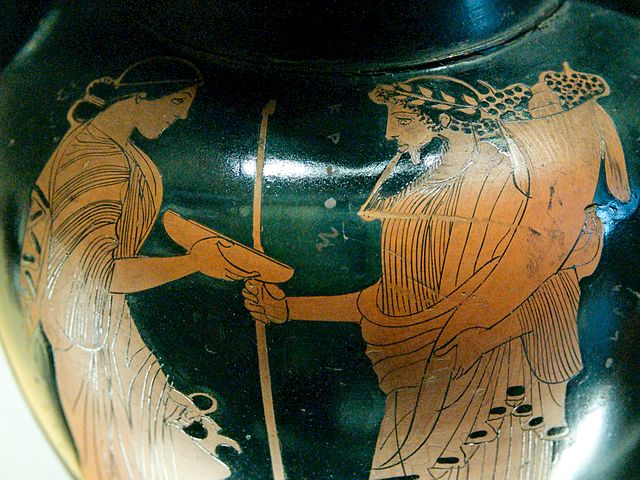Hades, in the ancient Greek religion and mythology, is the god of the dead and the king of the underworld, with which his name became synonymous. Hades was the eldest son of Cronus and Rhea, although this also made him the last son to be regurgitated by his father. He and his brothers, Zeus and Poseidon, defeated their father's generation of gods, the Titans, and claimed joint rulership over the cosmos. Hades received the underworld, Zeus the sky, and Poseidon the sea, with the solid earth available to all three concurrently. In artistic depictions, Hades is typically portrayed holding a bident
and wearing his helm with Cerberus, the three-headed guard-dog of the underworld, standing at his side.
Hades/Serapis with Cerberus, mid-2nd century AD statute from the Sanctuary of the Egyptian Gods at Gortyna
Hades (right) and Persephone (left). Detail from an Attic red-figure amphora, c. 470 BC. From Italy
Pinax with Persephone and Hades Enthroned, 500-450 BC, Greek, Locri Epizephirii, Mannella district, Sanctuary of Persephone, terracotta – Cleveland Museum of Art
Red figure volute krater with scene of the underworld, follower of the Baltimore Painter, Hermitage
Religious practices in ancient Greece encompassed a collection of beliefs, rituals, and mythology, in the form of both popular public religion and cult practices. The application of the modern concept of "religion" to ancient cultures has been questioned as anachronistic. The ancient Greeks did not have a word for 'religion' in the modern sense. Likewise, no Greek writer known to us classifies either the gods or the cult practices into separate 'religions'. Instead, for example, Herodotus speaks of the Hellenes as having "common shrines of the gods and sacrifices, and the same kinds of customs."
Aegeus at right consults the Pythia or oracle of Delphi. Vase, 440–430 BCE. He was told "Do not loosen the bulging mouth of the wineskin until you have reached the height of Athens, lest you die of grief", which at first he did not understand.
Aphrodite riding a swan: Attic white-ground red-figured kylix, c. 460, found at Kameiros (Rhodes)
Asclepios, god of medicine. Marble Roman copy (2nd century CE) of a Greek original of the early 4th century BCE. Asclepios was not one of the Twelve Olympians, but popular with doctors like Pausanias, and their patients.
The Judgment of Paris by Peter Paul Rubens (c. 1636), depicting the goddesses Hera, Aphrodite and Athena, in a competition that causes the Trojan War. This Baroque painting shows the continuing fascination with Greek mythology








